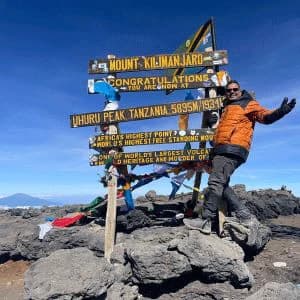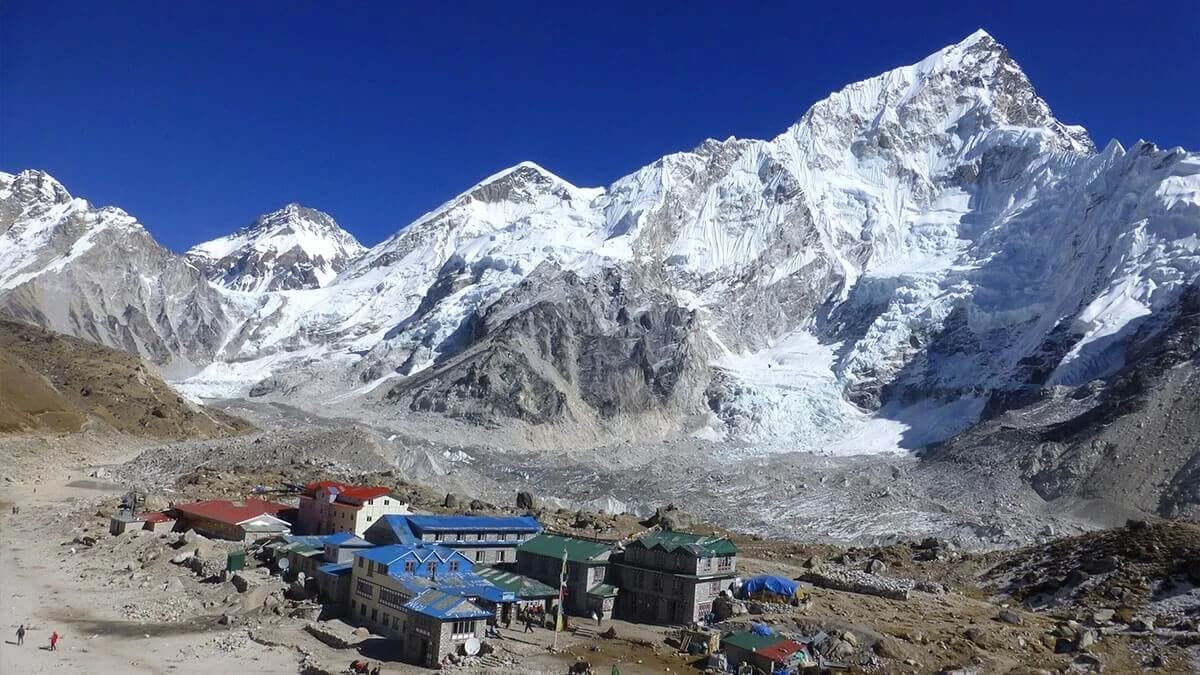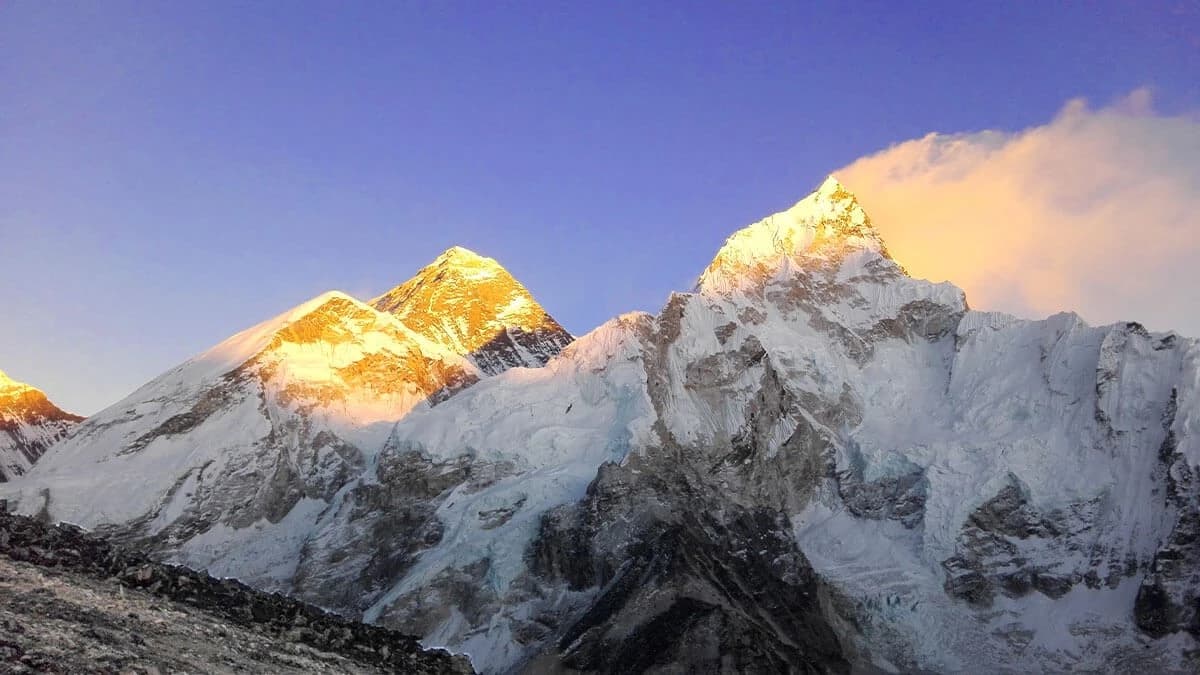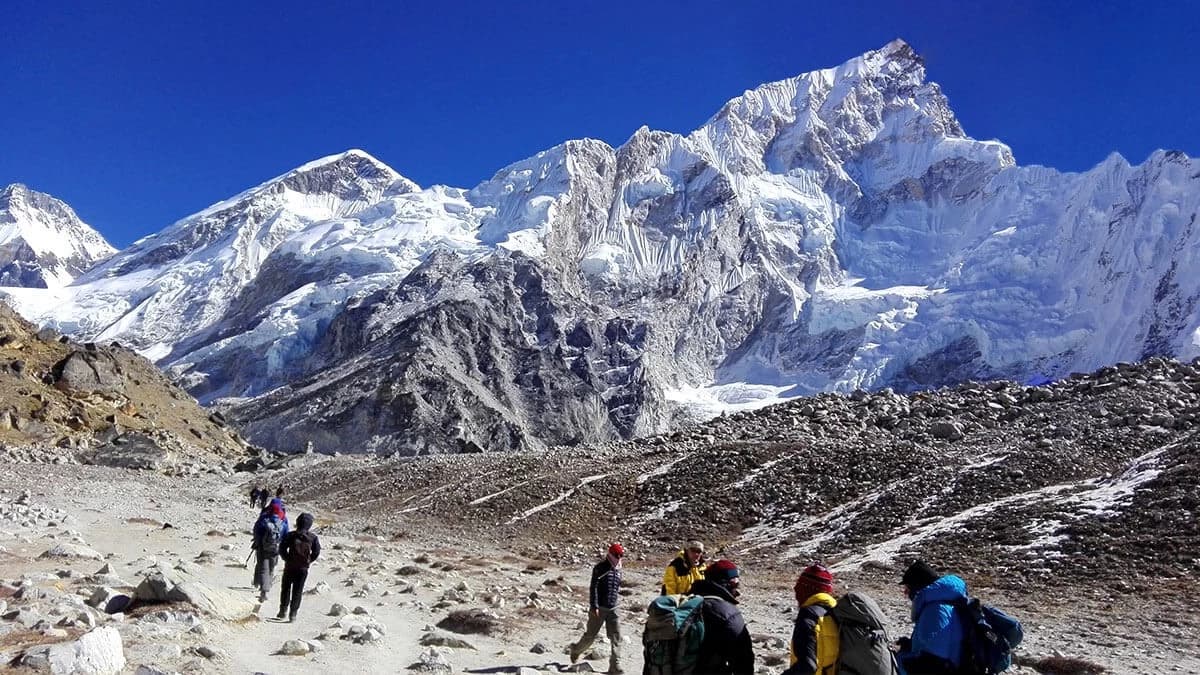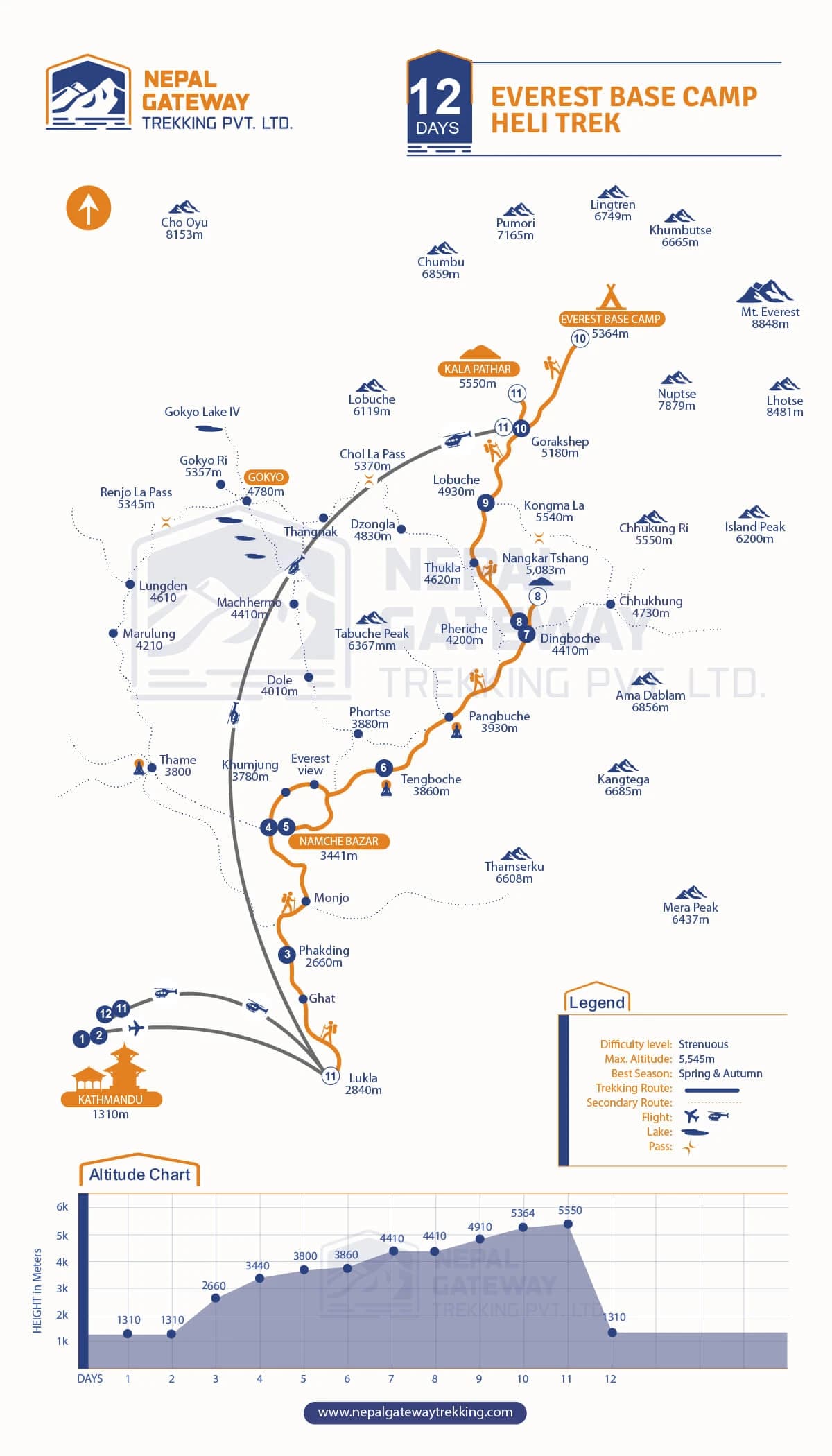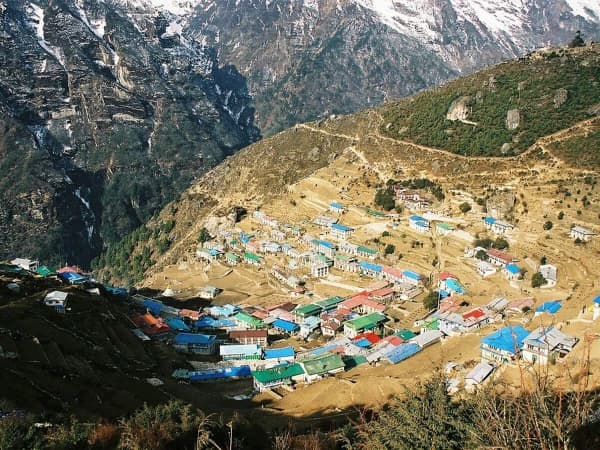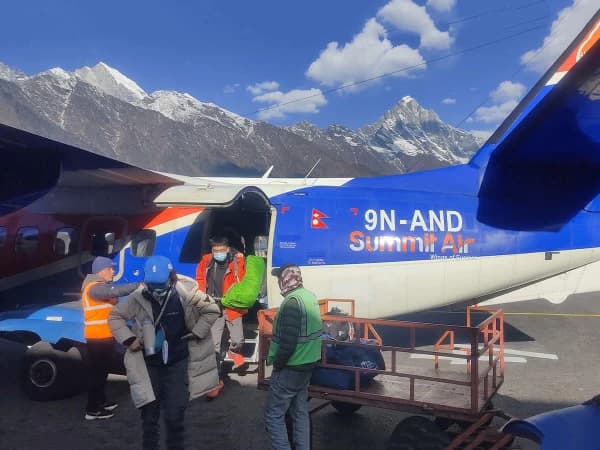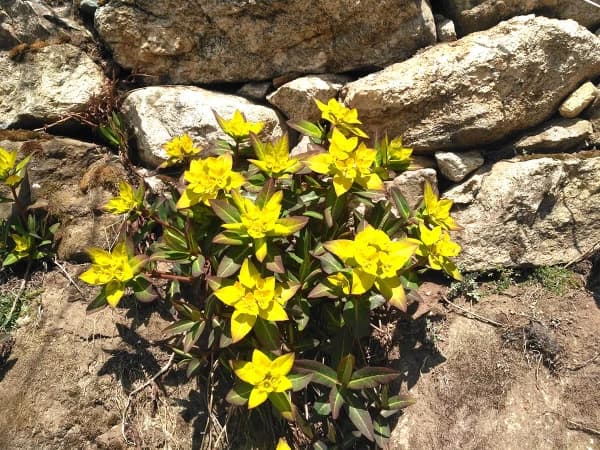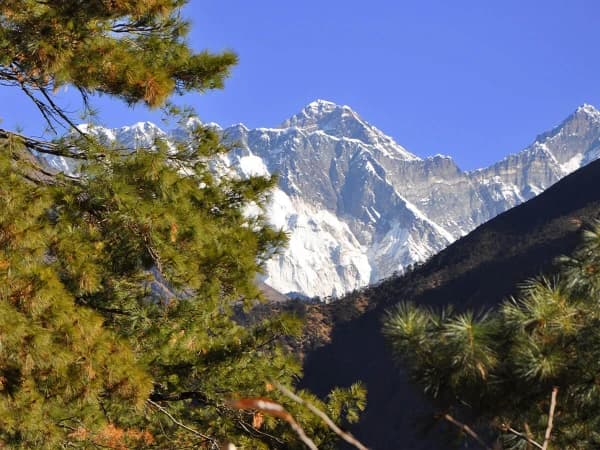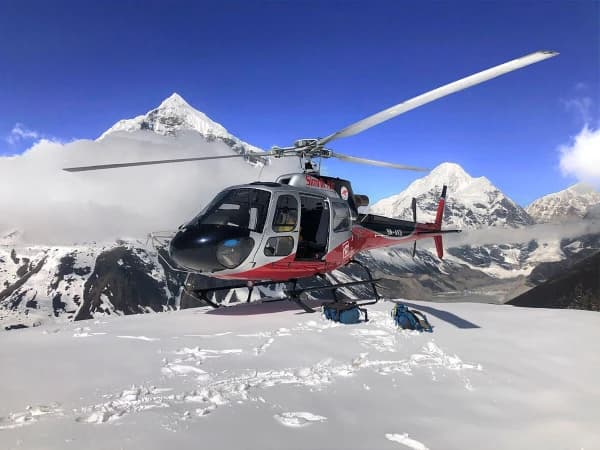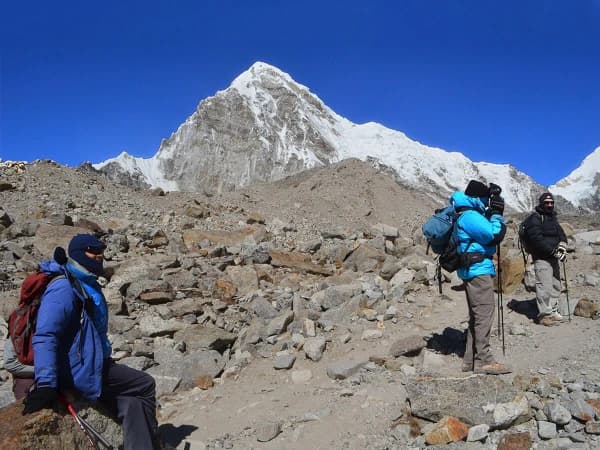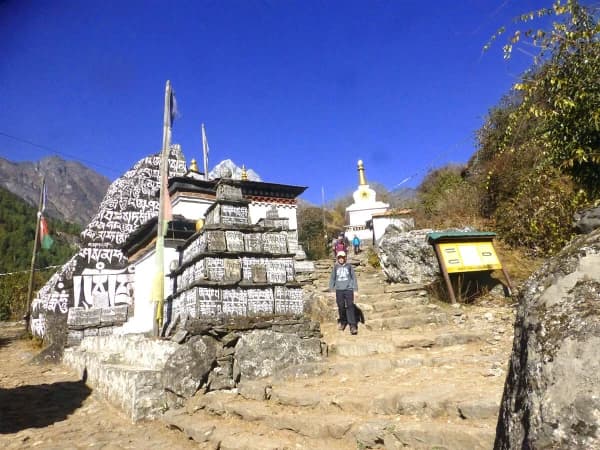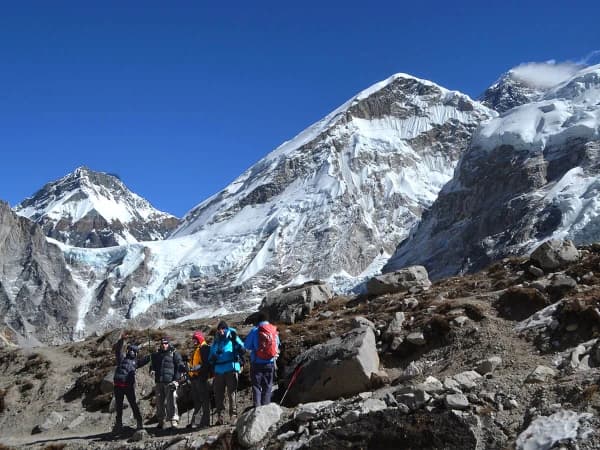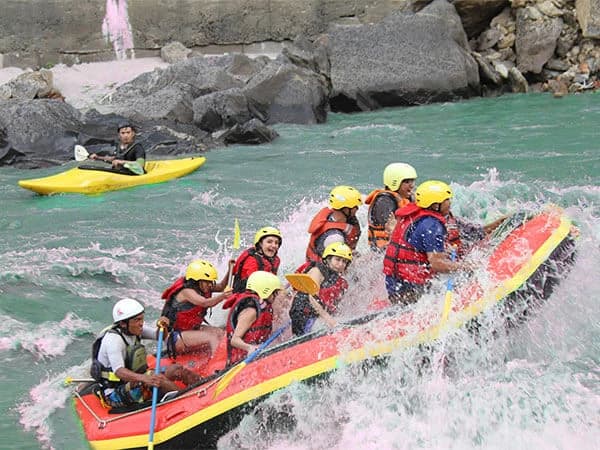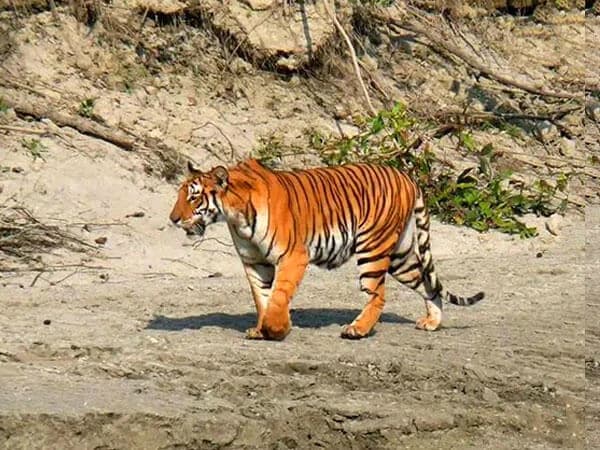Trek through picturesque Sherpa villages and century-old monasteries with tremendous mountain views in the Everest Base Camp Heli Trek.
Everest Base Camp Heli Trek
Everest Base Camp Heli trek, 12 days, offers the perfect mix of adventure and luxury. This short EBC trek with helicopter returns takes you to the famous Everest Base Camp at 5,364 meters, through stunning Sherpa villages like Namche Bazaar and Tengboche. The luxury EBC trek ends with a thrilling helicopter return from Gorak Shep, giving you breathtaking aerial views of Mount Everest and the Himalayan peaks.
The EBC trek with helicopter return became popular when adventurous travelers wanted to experience trekking to Everest Base Camp, Nepal, without the long walk back along the same route. This Everest Base Camp heli return option started in the early 2000s when helicopter services became more reliable in the Himalayas. The Everest trek with heli return now attracts trekkers who want to save time while enjoying the whole mountain experience.
During the EBC with a heli trip, you’ll meet the amazing Sherpa people, famous for their mountain climbing skills. The 12-day EBC trek itinerary takes you through traditional Buddhist villages where you’ll see colorful prayer flags and ancient monasteries. You’ll also encounter other ethnic groups like the Rai and Tamang, each with unique customs and warm hospitality.
The Everest Base Camp trek passes through Sagarmatha National Park, a UNESCO World Heritage Site. This protected area is home to rare animals like snow leopards, Himalayan bears, and the colorful Himalayan pheasants. You’ll walk through rhododendron forests, cross glacial rivers, and see dramatic landscapes of towering peaks and deep valleys.
Important Note: During the peak season, flights will be operated from Manthali Airport, Ramechhap, to Lukla. In the spring, from mid-March to mid-May and late September to November in autumn, all flights take off and land at Manthali Airport.
The Manthali airport, Ramechhap, is 142 km from Kathmandu, a 4-5 hour drive. To catch a flight to Lukla from Ramechhap, you must depart from Kathmandu from 1 a.m. to 2 a.m.
We highly recommend that you come with at least one more extra day for jet lag, especially considering the early morning drive to Manthali Airport, which benefits from adequate rest and sleep beforehand.
Major Highlights of Everest Base Camp Trek with Helicopter Return
- Reach Everest Base Camp (5,364 m): Stand at the world’s most famous base camp beneath Mount Everest.
- Summit Kala Patthar (5,545 m): Get the best close-up views of Mount Everest from this viewpoint.
- Helicopter Flight from Gorak Shep: Fly above the Himalayas with stunning aerial mountain scenes.
- Trek Through Sagarmatha National Park: Hike in Nepal’s UNESCO World Heritage mountain park.
- Explore Namche Bazaar: Visit the colorful Sherpa market town called “Gateway to Everest.”
- Visit Tengboche Monastery: Experience ancient Buddhist culture at this sacred mountain monastery.
- Cross Suspension Bridges: Walk across thrilling high bridges over glacial rivers.
- See Glorious Sunrise from Kala Patthar: Watch golden sunlight hit Mount Everest at dawn.
- Save Time with Helicopter Return: Skip the long walk back and fly out comfortably.
- Follow Hillary’s Route: Walk the same path as the first Everest climbers.
Route Overview of Everest Base Camp (EBC) Heli Trek
The Everest Base Camp trek with helicopter return follows Nepal's classic EBC trek route, through the heart of the Khumbu region. The EBC adventure trek begins with an exciting flight to Lukla airport at 2,860 meters. This exciting landing on one of the world’s most thrilling runways marks the start of an incredible journey into the Himalayas.
From Lukla, the EBC trail leads you to Phakding, a peaceful village along the Dudh Koshi River. This first day offers gentle walking and helps you adjust to the mountain environment. The route passes through beautiful forests and traditional Sherpa settlements, giving you a taste of local Sherpa culture and hospitality.
The EBC trekking route then climbs to Namche Bazaar, the famous gateway to Everest at 3,440 meters. This bustling market town serves as the central hub for all Mount Everest expeditions. You’ll spend an extra day here for proper acclimatization, exploring local markets and enjoying stunning mountain panoramas from the town’s hillside location.
The Everest Base Camp trek, 12 days, continues to Tengboche monastery, perched dramatically at 3,867 meters. This scenic site offers breathtaking sights of Everest, Lhotse, and Ama Dablam peaks. The monastery provides a spiritual highlight of the EBC journey with its ancient Buddhist traditions and peaceful mountain setting.
The EBC with helicopter return trip takes you next to Dingboche at 4,410 meters for another crucial acclimatization stop. This high-altitude village sits in a broad valley surrounded by towering peaks. Following proper altitude guidelines, you’ll use this rest day to hike higher elevations and return to sleep lower.
From Dingboche, the Everest trek map shows the route climbing to Lobuche through increasingly barren landscapes. You’ll pass the moving Thukla Pass memorials and trek alongside the massive Khumbu Glacier. As you approach the high-altitude zone above 5,000 meters, the terrain becomes more rugged and dramatic.
The EBC heli trek climaxes at Gorak Shep and Everest Base Camp at 5,364 meters. You’ll also climb Kala Patthar for the best sunrise views of Everest’s summit. These final destinations represent the ultimate goal of your trekking adventure, offering once-in-a-lifetime views and photo opportunities.
The Kala Patthar helicopter return completes the Everest base camp trek route with a helicopter in spectacular style. Instead of walking back down for several days, you’ll fly directly to Kathmandu in just over an hour. This helicopter option saves time and energy while providing amazing aerial views of the Himalayan range you just conquered.
Why Choose Nepal Gateway Trekking for the Everest Base Camp Trek with Helicopter Return?
Official Registration and Full Licensing: Nepal Gateway Trekking is fully licensed by the Nepal Tourism Board (NTB) and registered with the Trekking Agencies’ Association of Nepal (TAAN). This establishes us as a trusted trekking agency in Kathmandu with all legal certifications. You can book the Everest Base Camp trek with helicopter return with complete confidence knowing we meet all government standards.
Proven Experience and Expertise: We are recognized as the best company, EBC Trek Nepal, with years of specialized experience in the Everest region. Our team has perfected the helicopter return through countless successful treks. This expertise ensures the Nepal Gateway Trekking EBC trek runs smoothly from start to finish.
Transparent Pricing with No Hidden Costs: We are here with transparent, all-inclusive pricing so you know exactly what you’re paying for when you book. No surprise fees or hidden charges will appear during the trek. Our transparent approach has earned excellent Nepal trekking company reviews from satisfied clients.
Uncompromising Safety Standards: Your safety is our top priority on every guided Everest trek we operate. Our guides are trained in first aid and high-altitude medicine with proper emergency evacuation plans. We follow carefully planned acclimatization schedules to minimize altitude sickness risks.
Expert Local Guides and Ethical Porter Treatment: Our licensed guides know much about the mountains' culture, geography, and weather and can speak English very well. We treat our porters ethically with fair wages and proper equipment. This commitment makes us a responsible tour operator for the EBC trek adventure.
Fully Customizable Itineraries: Every trekker has their own needs, fitness levels, and time constraints. We offer flexible trek lengths, extra rest days, various helicopter pick-up and drop-off points, and optional side trips. Your Everest base camp experience is customized to your interests.
Outstanding Client Reviews and Reputation: Our 5-star rating on TripAdvisor and Google demonstrates our commitment to exceptional service. Previous trekkers have praised our friendly guides, safety measures, and general service quality. Read these testimonials from satisfied customers to see why we're the best choice for our EBC trip.
Commitment to Sustainability and Local Communities: We hike sustainably using proper trash management. In addition to minimal environmental impact, we are here to help local Sherpa communities directly by giving them fair jobs. By choosing us, you support the region’s sustainable future.
24/7 Comprehensive Support: From your initial query to safe return home, we are here for you 24/7. Our team assists with pre-trek preparation, monitors your progress during the journey, and handles logistics. This dedicated service sets us apart as a trusted partner for your Himalayan adventure.
Itinerary
This is our standard and recommended Everest Base Camp Heli Trek itinerary.
Welcome to Nepal! A Nepal Gateway Trekking representative will meet you at Kathmandu International Airport. He'll drive you straight to the hotel in Thamel. Take it easy today and rest well. Your body needs time to get used to the altitude before starting the Everest Base Camp trek with helicopter return.
Explore Thamel’s busy streets and colorful markets in the afternoon. Try local food at cozy restaurants and cafes. If time allows, meet a trip leader briefly and learn about the 12-day EBC trek plan. He will explore the Everest Base Camp 12-day itinerary and check your gear. You can buy or rent missing items right here in Thamel.
Start your morning exploring the UNESCO World Heritage sites in Kathmandu Valley. Visit Pashupatinath Temple, Nepal’s most sacred Hindu temple, by the holy river. See Swayambhunath Temple, known as Monkey Temple, sitting high on a hill with great valley views.
Explore Boudhanath Stupa, one of the world’s largest Buddhist stupas, with colorful prayer flags. Walk through Kathmandu Durbar Square, the world's royal palace with marvelous wood carvings.
Return to the hotel after sightseeing to prepare for the Everest Base Camp trek with helicopter return. Pack your backpack and attend the trip briefing if you missed it yesterday. While you explore the city, Nepal Gateway Trekking will arrange all your trekking permits. Get a good night’s sleep tonight because tomorrow you fly to Lukla early in the morning.
Leave your hotel early and drive to the airport for a flight to Lukla. The EBC trekking adventure begins from Lukla, the gateway to the Everest region. The 40-45 minute flight offers fantastic mountain vistas of Ganesh Himal, Langtang, and distant Everest peaks. Lukla airport buzzes with excited trekkers and friendly locals ready to start their journey.
After landing, hand over heavy bags to porters and explore Lukla if needed. The town has gear shops, ATMs, and pharmacies for last-minute shopping. After breakfast, start walking on the famous EBC trail toward Phakding. This first day is easy and comfortable, perfect for warming up your muscles.
The trail from Luka to Phakding is mostly flat and downhill through beautiful forests. Walk through traditional Sherpa hamlets and cross exciting suspension bridges over the Dudh Khosi River. Enjoy views of Kusum Kanguru peak along the way. Phakding sits peacefully beside the river with cozy teahouses and warm local hospitality waiting for you.
Important Note: During the peak season, flights will be operated from Manthali Airport, Ramechhap, to Lukla. In the spring, from mid-March to mid-May and late September to November in the autumn season, all flights take off and land at Manthali Airport.
The Manthali airport, Ramechhap, is 142 km from Kathmandu, a 4-5 hour drive. To catch a flight to Lukla from Ramechhap, you must depart around 1 a.m. to 2 a.m. from Kathmandu.
Today brings one of the longest hiking days on the Everest base camp journey. You’ll start by crossing a wobbly suspension bridge over the rushing Dudh Koshi River. The trail goes through photogenic valleys and past rushing streams. Small Sherpa settlements like Zamfute, Toktok, and Monjo dot the path.
At Monjo village, you’ll reach the entrance to Sagarmatha National Park. Here, you’ll show your trekking permit to the guards. The trail gets much steeper as you climb toward Namche Bazaar through thick pine forests. On clear days, you might catch the first distant glimpse of mighty Mount Everest towering above the other peaks.
Namche Bazaar welcomes you as the bustling capital of Sherpa culture. This mountain town buzzes with markets, shops, and fellow trekkers worldwide. Along today’s trail, you’ll see vivid waterfalls, spot colorful birds, and maybe even catch sight of the rare Himalayan Tahr grazing on the slopes.
An acclimatization day in Namche Bazaar is crucial for adjusting to the thin mountain air, and to avoid altitude sickness, you must follow the golden rule—"hike high, sleep low." The popular Hotel Everest View hike takes 3-4 hours and offers eye-catching sights of Mount Everest, Lhotse, and Ama Dablam. This gradual climb helps your body adapt while you return to sleep at a lower altitude.
There is an option of side trips to Khumjung and Khunde villages nearby. Khumjung houses the famous Hillary School and a monastery with the mysterious “Yeti Scalp.” Khunde has a small hospital that Sir Edmund Hillary founded. Another option is a short hike around Namche Bazaar to Syangboche Airstrip for great mountain photos and light exercise.
If hiking isn’t your thing, explore Namche’s colorful local market instead. Browse handmade crafts, trekking gear, and soft yak wool products from local shops. Explore the Sherpa Museum and learn about mountain culture and Everest climbing history. Namche has cozy tea houses where you can rest, chat with fellow trekkers, and enjoy hot meals.
Today’s trek begins with a gentle climb along the valley wall on this classic EBC trek route through Nepal. You’ll enjoy jaw-dropping sights of Mount Everest, Lhotse, Nuptse, and the stunning Ama Dablam peak. The first half follows a smooth, mostly flat path through green forests and the small village of Kyangjuma. This Everest Base Camp itinerary section offers some of the most picture-perfect mountain scenery.
The trail turns into a steep climb after crossing suspension bridges over the Dudh Koshi River. The pathway goes through lush woods of pine, juniper, and colorful rhododendrons. The trail winds upward toward the famous Tengboche village. The climb can be challenging, but the forest scenery keeps you motivated.
Tengboche Monastery sits at 3,860 meters and serves as the spiritual heart of the region. The largest monastery in the Khumbu offers stunning 360-degree panoramas of the Everest massif. Colorful prayer flags flutter in the mountain breeze around the peaceful grounds. Explore the monastery and witness traditional Buddhist ceremonies during your visit.
Fact: This village is home to the biggest monastery in the Khumbu region, the Tengboche monastery.
Start a day watching the spectacular morning light paint the mountain peaks from Tengboche. The trail gently descends through colorful rhododendron forests to the small settlement of Debuche. You’ll cross the rushing Imja Khola River on a swaying suspension bridge. From here, the path climbs gradually to Pangboche village at 3,985 meters, the highest year-round settlement on the EBC trek with a helicopter return journey.
At Pangboche, visit the ancient monastery– the oldest in the entire Khumbu region. This historic site holds precious artifacts and deep cultural meaning for local Sherpas. Along the way to Shomare town, the trail continues through a barren but lovely alpine scenery. This small settlement makes a perfect spot for lunch and rest before the final push.
Throughout the day, stunning sights of Ama Dablam dominate the skyline– many call it the world’s most lovely mountain. The landscape gradually opens up as trees become scarce and rocky terrain takes over. The day ends in picturesque Dingboche village, surrounded by towering peaks and sublime mountain scenery. This important stop provides comfortable guesthouses and is a key acclimatization point for trekkers.
Fact: This village is also known as the Summer Valley.
Your Dingboche acclimatization day is another crucial rest stop on the EBC journey. This day lets your body adjust to the thin air while enjoying amazing alpine views. The popular Nangkartshang Peak hike starts from Dingboche and climbs steeply upward. The Nangkartshang peak trail follows stone markers and offers panoramic views as you climb higher.
This half-day hike is steep but not technical, making it perfect for acclimatization training. You’ll see astonishing 360-degree panoramas of Ama Dablam, Lhotse, Makalu, and Island Peak. The trail is much quieter than the main EBC trail, giving you peaceful moments and great photo chances. This ascent is a great way to prepare your body for the higher altitudes at Lobuche and Gorak Shep.
Take side trips from Dingboche hamlet to nearby Chhukung Valley to do more exciting things. This easy walk offers gradual elevation gain and enticing Imja Valley scenery. You can also explore Dingboche by visiting local bakeries and relaxing at cozy teahouses. The village sits in a broad valley surrounded by towering peaks like Ama Dablam and the massive Imja Glacier.
The journey from Dingboche to Lobuche starts with splendid views of a hilltop stupa. As you walk, the massive peaks of Tawache, Cholatse, and Pumori come into sight. The trail passes above Pheriche village and leads to Thukla, a perfect spot for lunch and rest. This section offers impressive sights of the Imja Valley and the surrounding mountains.
After leaving Thukla village, the real challenge begins with a steep climb up the glacial moraine of Khumbu Glacier. The zigzag path is challenging but short, so take your time at this high altitude. At Thukla Pass, you’ll find the moving Thukla Pass memorials dedicated to climbers like Scott Fisher and Babu Chhiri Sherpa. These cairns and monuments remind us of those who lost their lives on Everest.
The final stretch follows the edges of the Khumbu Glacier toward Lobuche town. The landscape changes dramatically from green meadows to bare, rocky terrain. Lobuche sits among towering peaks and offers stunning Nuptse and Pumori evening scenes. This high-altitude village is both dramatic and peaceful.
Today marks the most exciting day of the Everest base camp trekking itinerary. First, you hike to Gorak Shep, the last settlement before the base camp. This remote outpost is where you'll stop for lunch and is the final rest point. The trail alongside the mighty Khumbu Glacier offers stunning Himalayan vistas.
The path from Gorak Shep to Everest Base Camp takes you over rocky moraines and sandy terrain. You’ll see glimpses of bright blue glacial ice and dramatic icefalls. The massive Everest-Lhotse wall appears closer than ever before. This section showcases some of the most iconic Himalayan landscapes you’ll ever witness.
Reaching Everest base camp at 5,364 meters is a milestone for trekkers worldwide. The famous Khumbu Icefall stretches before you, showing the challenging route climbers must face. Towering peaks like Nuptse, Pumori, and Lingtren surround the base camp area. The setting feels both dramatic and humbling at this altitude.
During the spring months, base camp comes alive with colorful tents and climbers preparing for the Everest summit attempts. You’ll have plenty of time to soak in this incredible achievement and take photos. An Everest Base Camp heli trek offers similar panoramas with less physical demand for those considering alternatives. Today’s success results from many days of hard work and commitment.
The final day starts before dawn with a hike to Kala Patthar for the famous sunrise panorama. This viewpoint offers the best panoramic views of Mt. Everest, Lhotse, Nuptse, and Ama Dablam. Watching Everest glow in golden morning light creates the perfect Kala Pathhar sunrise view experience. The summit provides an ideal spot for photography and quiet reflection on the remarkable journey.
The downhill walk back to Gorak Shep takes only 1 to 1.5 hours and feels much easier. You’ll quickly grab breakfast and prepare for a helicopter departure. This marks the beginning of the most exciting part of the Everest Base Camp trek with a heli return. You'll fly back to Kathmandu instead of trekking down the same trail for 3-4 days.
The helicopter return from EBC has several benefits over traditional trekking down. Your valuable time is saved, and you keep your knees and feet from getting sore after days of hard climbing. The flight takes just 1-1.5 hours and eliminates the risks of downhill trekking at high altitude. You can still complete the full EBC circuit to its highest point.
During the scenic flight, relish stupendous views of Everest and the glacial landscapes below. Scenes of Sagarmatha National Park and its tiny hamlets are surreal from up here. When you get back to Kathmandu, you can look around and buy some souvenirs. This helicopter option makes the EBC adventure both complete and pleasant.
Today marks the end of the phenomenal Everest Base Camp adventure. You’ll drive to Kathmandu International Airport to begin your journey home. After completing all airport formalities, the international flight will be ready for departure. If you have extra time before your flight, you can do some last-minute souvenir shopping at the airport.
An amazing trek to Everest Base Camp comes to a close with unforgettable memories. You’ve achieved something remarkable by reaching the world’s famous base camp. Nepal Gateway Trekking offers many other tour packages in Nepal, Bhutan, and Tibet for future adventures. Contact us for more information about exploring these beautiful Himalayan regions.
Dates & Availability
Private tripCost Includes
- All ground transportation as per itinerary by private car.
- One expert tour guide for Kathmandu Valley sightseeing, inclusive of entrance fees.
- Three nights’ accommodation at a three-star category hotel in Kathmandu, inclusive of breakfast.
- Kathmandu to Lukla or Ramechhap to Lukla flight tickets inclusive of domestic airport taxes.
- Gorak Shep to Lukla to Kathmandu helicopter expenses.
- Three meals (breakfast, lunch, and dinner) on the trek.
- Twin sharing attached bathroom during the trekking.
- One highly experienced government license holder, an English-speaking trekking guide.
- Required porters (1 porter between 2 trekkers). A porter is not included for solo trekkers.
- Sagarmatha National Park permit and TIMS card.
- Everest Base Camp trekking map.
- Nepal Gateway Company T-Shirt.
- Local fresh fruits (apples, pomegranates, and oranges) are served as a dessert every evening after your dinner.
- First aid kit with oximeter to check heartbeat and oxygen level regularly.
- Emergency helicopter evacuation assistance if it is necessary because of the altitude sickness.
- All necessary government taxes.
- Office service charges.
Cost Excludes
- Lunches and dinners in Kathmandu.
- Your travel insurance.
- Nepal entry visa, which can be obtained upon your arrival at Kathmandu Airport.
- Your international flight ticket to/from Kathmandu.
- All kinds of hot drinks (tea/coffee/hot water) during the trek.
- All kinds of cold drinks (mineral water, Coke, and Fanta) and alcoholic beverages on trekking.
- Your personal nature expenses and equipment and medical kit.
- Tipping to field staff (tipping is not mandatory but expected).
Good To Know
Everest Base Camp Trek with Helicopter Return Cost
The cost for Everest Base Camp trek with helicopter return in 2025 typically ranges from USD 3150 to USD 2400 per person for standard group packages. The EBC helicopter trek prices in Nepal vary greatly depending on group size, lodging facilities, and helicopter service quality. Solo trekkers pay premium rates, but larger groups share costs and pay less per person. Peak season pricing during spring and autumn is generally higher than off-season rates.
Standard Everest Base Camp package price includes airport transfers, domestic flights to and from Lukla, professional guides and porters, and all necessary permits. Your accommodation in tea houses, meals during the trek, and the helicopter flight from Gorak Shep back to Kathmandu are usually included. If you select luxury choices, the 12-day EBC trek cost might go up to USD 4200 to USD 3500 per person. Private helicopter charters, high-end lodge accommodations, and personalized services drive these premium rates.
Several other factors influence the final EBC Heli trek cost. Extra charges apply for gear rental or purchase, Wi-Fi usage, battery charging, and optional services like hot showers. Tips for guides and porters are customary and should be budgeted separately. Most trek packages don't cover travel insurance, visa fees, and personal expenses in Kathmandu.
Best Time for Everest Base Camp Heli Trek
The best time for the Everest base camp heli trek falls during two prime seasons: spring and autumn. These months offer perfect conditions for both trekking and helicopter flights. During these times, there will be clear mountain vistas, calm weather, and safe flying conditions.
The spring season, from March to May, is ideal for both treks and EBC helicopter tours. The EBC trek with heli return in April has pleasant weather, with temperatures ranging from 10-15°C at lower elevations. The rhododendrons bloom beautifully, creating stunning landscapes along the trail. Helicopter flights operate smoothly with minimal weather delays.
Autumn is the best season for the EBC helicopter trek with crystal-clear skies and superb visibility. The autumn weather is ideal, offering crisp air and comfortable daytime temperatures. EBC trek in October provides the most stable conditions with rare rainfall and excellent mountain vistas. EBC trails are well-defined and dry after the monsoon ends. Helicopter operations run reliably with consistent weather patterns and minimal flight cancellations.
Winter and monsoon seasons should be avoided for this adventure. Winter brings freezing temperatures and heavy snow that can block trails and helicopter landings. Monsoon season causes slippery paths, poor visibility, and frequent flight delays, significantly impacting travel plans.
Everest Base Camp Trek with Helicopter Return Permits
Planning the EBC trekking permits is essential for a smooth journey to the world’s most famous base camp. You must get the Sagarmatha National Park and Khumbu Pasang Lhamu Municipality permits. Both permits serve different purposes and are obtained from specific locations along the route.
Nepal's EBC trek permit cost varies depending on your nationality and the specific permit. The Sagarmatha National Park permit costs NPR 3,000 ($25-30) for foreign nationals and NPR 1,500 for SAARC citizens. You can get this national park permit from the Nepal Tourism Board in Kathmandu or Monjo, the park’s entry checkpoint.
The Khumbu permit, officially known as the Khumbu Pasang Lhamu Rural Municipality permit, costs NPR 3,000 ($25-30) for foreigners and NPR 1,000 for SAARC citizens. To acquire these Everest base camp passes, you’ll need a valid passport, photocopies, and 2-4 passport-sized photographs. The Khumbu permit is only accessible from the municipality office in Lukla or Monjo, not Kathmandu.
Difficulty Level of Everest Base Camp Trekking with Helicopter Return
The difficulty level of Everest Base Camp trek with helicopter return falls into the moderate to challenging category. This special combo considerably reduces the overall physical strain compared to the standard round-trip route. The helicopter return eliminates the exhausting descent, cutting the trekking distance in half from 130km to just 65km. However, the ascent to Mount Everest Base Camp and Kala Patthar still demands good physical fitness and mental preparation.
The main challenge of the EBC trek lies in the high altitude, with Kala Patthar reaching 5,545 meters above sea level. The EBC trip begins at Lukla (2,860m) and goes up slowly to Everest Base Camp (5,364m). The main physical concerns are altitude sickness and oxygen depletion. The itinerary includes proper acclimatization days to help your body adjust safely to the thin air.
The fitness level for the EBC trek requires moderate to high endurance as you’ll trek 7-8 hours daily over demanding terrain. You’ll have to cross suspension bridges, stone staircases, and uneven, rocky paths that can be steep and challenging. Depending on the season, the EBC route may have snow or ice, adding further challenges. Getting to these heights requires both physical and mental toughness.
Training for Trekking to Everest Base Camp with Helicopter Return
Training for Everest Base Camp trek includes building endurance, strength, and cardiovascular fitness. While the helicopter return eliminates the demanding descent, getting to the base camp still demands serious physical conditioning. Start fitness training for the EBC trek at least 2-3 months before departure. The better prepared you are, the more you’ll enjoy the splendid mountain scenery instead of just surviving each day.
The EBC fitness training should emphasize cardiovascular endurance through regular jogging, cycling, or swimming 3-4 times weekly. Aim for 45 to 60-minute sessions to prepare for those 5-7 hour trekking days in thin mountain air. The best exercises for the Everest trek include strength training with squats, lunges, step-ups, and calf raises for leg power. Don’t forget core work with planks and upper body exercises to handle your backpack comfortably during long hiking days.
Incorporate frequent hiking practice on varied, uneven terrain with a loaded backpack (8-10kg) to prepare for the EBC trek helicopter return. To increase your resistance and replicate real Himalayan trekking conditions, gradually increase the hike duration to 4 to 6 hours. Practice the “climb high, sleep low” strategy during training hikes.
Mental preparation for the Everest trek is equally necessary as physical conditioning. Yoga and meditation are good for building mental resilience. The remote mountain environment means basic accommodation and limited facilities, so prepare mentally for these challenges. Visualize yourself completing each day's trek and reaching Base Camp. Remember, this outstanding EBC trek requires physical fitness and mental toughness to fully appreciate the majesty of the world’s highest peaks.
Altitude Sickness During Everest Base Camp Hike with Helicopter Return
Altitude sickness during the Everest Base Camp hike with a helicopter return poses serious risks due to extreme elevations. Symptoms typically start above 2,500 meters and peak near base camp at 5,364 meters. Even with a helicopter return, high-altitude trekking in Nepal exposes you to dangerous complications.
The trek climbs rapidly from Lukla at 2,860 meters to Gorak Shep at 5,545 meters. This quick ascent increases the risk of acute mountain sickness EBC, and severe conditions like HACE and HAPE. Between Namche Bazaar and Lobuche, 30 to 50 percent of hikers get altitude sickness.
Common symptoms include headaches, nausea, fatigue, and dizziness. In severe cases, trekkers may become confused, have breathing problems, and lose their balance. Preventing altitude sickness involves following proper acclimatization schedules and staying hydrated throughout the journey.
Everest trek safety requires listening to your body and acting quickly when symptoms appear. Never ascend with worsening symptoms– rest or descend immediately. Carry Diamox medication as prescribed and discuss emergency evacuation plans with the trek operator for maximum protection.
Travel Insurance for Hike to Everest Base Camp with Helicopter Return
Travel insurance Everest Base Camp trek is not just recommended but essential. The trek takes you above 5,000 meters, where altitude sickness and medical emergencies are common. Without proper EBC trek insurance, you could face devastating financial costs from emergencies.
Helicopter evacuation insurance in Nepal becomes crucial when the weather turns dangerous or medical issues arise. Emergency helicopter rescues from high altitudes can cost thousands of dollars. The best insurance for the EBC trek must cover evacuations up to 6,000 meters altitude to ensure you’re fully protected.
Mountain weather is unpredictable and can cause flight delays or trip cancellations. The high-altitude trekking insurance should cover trip interruptions, baggage loss, and accommodation extensions. These unexpected costs can quickly add up without proper coverage.
Most trekking agencies require proof of comprehensive insurance before issuing permits. The policy must include medical expenses, hospitalization, emergency evacuation, and 24/7 international assistance. Purchase the travel insurance before departing for Nepal to ensure complete peace of mind on the adventure.
Route Variations for Trek to Everest Base Camp with Helicopter Return
Gokyo Lakes Trek
The Gokyo Lakes trek is a great route variation following the alternative peaceful trail to Gokyo Valley. In this less-crowded trail, you’ll discover pristine high-altitude lakes and climb Gokyo Ri to get a view of Everest that will take your breath away.
Everest Three Passes Trek
The Everest Three Passes trek is the most challenging route variation for the EBC trek with a heli return. You'll navigate three high mountain passes: Renjo La, Cho La, and Kongma La. You’ll combine Everest Base Camp with extended trekking routes for extraordinary panoramic scenery. This adventure suits experienced trekkers seeking the ultimate Himalayan challenge.
Ama Dablam Base Camp Trek
Another beautiful route variation for the EBC trek is hiking to the base camp of Mount Ama Dablam. You can take this route diversion after trekking to the traditional EBC route. Enjoying a less-traveled path, you’ll reach the base of Nepal’s most photogenic peak. The spectacular mountain vistas and unique perspective make this a photographer’s dream.
Rolwaling Valley Trek
An off-the-beaten-path adventure that combines Everest region highlights with the remote Rolwaling Valley. This route variation Everest Base Camp trek offers complete serenity and untouched natural beauty. Perfect for trekkers seeking wilderness solitude away from busy trails.
Helicopter Return Flexibility
Helicopter pick-up services are available in the Everest region to make the Everest treks shorter and more manageable. Choose pick-up points at Gorak Shep, Kala Patthar, or even Pheriche depending on the weather and your preferences. This flexibility lets you completely adjust the trek duration, difficulty level, and timing of your walk to fit your needs and schedule.
Accommodation on Everest Base Camp Trek with Helicopter Return
Everest Base Camp trek accommodation ranges from basic mountain teahouses to luxury lodges in Kathmandu. The EBC trek tea houses in Nepal are locally run establishments. Lodges along the EBC route range from simple facilities with shared bathrooms to premium accommodations with en-suite bathrooms and hot showers. Towns like Namche Bazaar, Dingboche, and Lukla feature more comfortable EBC accommodation options with enhanced amenities.
Most lodges on the EBC trek route provide twin beds, warm blankets, and low-wattage electricity for basic needs. The dining experience is communal, bringing trekkers together in cozy spaces heated by wood-burning stoves. Where to stay: EBC trek becomes more basic as you ascend, with facilities at Lobuche and Gorak Shep offering essential comfort rather than luxury.
Everest Base Camp heli trek accommodation follows the same mountain lodge system until your helicopter departure point. After reaching Everest Base Camp, you’ll spend one night at Gorak Shep before your scheduled helicopter pick-up. The helicopter return eliminates the need for multiple nights during the long descent back to Lukla.
Booking is essential for the best trekking experience, especially during peak seasons in spring and autumn. Popular stops like Namche Bazaar and Dingboche fill up quickly due to limited accommodation options at high altitude. Early reservations ensure you secure comfortable lodging and avoid sleeping in overcrowded dormitory-style rooms.
Food and Drinks on Everest Base Camp Trek with Helicopter Return
EBC trek food and meals follow a standard three-meal plan with breakfast, lunch, and dinner in the package. Breakfast and dinner are served at the overnight teahouse, and lunch is enjoyed along the trekking route.
Food on EBC trek with heli return features hearty, nutritious dishes perfect to fuel mountain adventure. There are both Nepalese and Western dishes on the menu. Nepalese favorites like Dal Bhat (rice, lentils, vegetables), momos, noodle soup, fried rice, and Tibetan bread. Western options include pasta, spaghetti, macaroni, and pizza.
What to eat on the EBC trek varies by altitude, with more diverse options available at lower elevations. For breakfast, there is an option of porridge, toast with jam, pancakes, omelets, and local breads like Sel Roti. Meals on the Everest trek become simpler as you ascend, focusing on carbohydrate-rich dishes for energy. Dal Bhat remains a trekker favorite, providing essential carbohydrates, protein, and fiber in one satisfying meal.
Vegetarian and vegan options are readily available, though choices become more limited at higher altitudes. Hot beverages include Nepali milk tea, masala tea, ginger lemon honey tea, garlic tea, and coffee to keep you warm. Cold drinks feature bottled water, soft drinks, and fresh juices at lower elevations. Local specialties like butter tea and yak milk tea offer authentic Himalayan flavors in select villages.
Everest base camp trek with helicopter return, food cost is included in the trip package. Meals on the EBC helicopter trip are always high quality; however, variety declines near Base Camp and Gorak Shep. Daily, you'll get a fresh meal from local ingredients and traditional cooking methods. Garlic soup is highly recommended for altitude acclimatization, while alcohol should be avoided at high elevations for health reasons.
Drinking Water Facilities During Everest Base Camp Trek with Helicopter Return
Drinking water on the EBC hike is essential to maintain good health and prevent altitude sickness. Drinking three to four liters of water daily is imperative to maintain proper hydration, particularly at high elevations, where sweating leads to considerable water loss. EBC trek drinking water facilities include multiple options ranging from natural resources to teahouse services. The key question many trekkers ask is whether water is safe on the EBC trek– the answer depends entirely on proper treatment and purification methods.
Everest teahouses serve boiled water, one of the safest and most convenient options throughout the EBC trek. The majority of lodges charge a small fee for hot, boiled water. Besides, water purification tablets are an excellent backup option for treating natural water sources like streams and rivers. Iodine or chlorine tablets are lightweight, affordable, and readily available in Kathmandu or Namche, requiring 20-30 minutes to purify water effectively.
Safe drinking water Everest trek is best achieved through filter water refill stations now available in many settlements. These eco-friendly stations allow you to refill reusable bottles. This way, you'll use fewer plastic water bottles along the trail. Natural water sources are abundant throughout the EBC route but drink it only after proper treatment.
During the EBC trek with heli return, we highly discourage bottled water due to environmental impact and excessive costs reaching USD 4 per liter at Gorak Shep. The region lacks plastic recycling infrastructure, making sustainable water practices essential to preserve the Himalayan environment. Bring a durable reusable bottle and drink boiling water from teahouses or properly treated natural sources.
Electricity and Communication on Everest Base Camp Trek with Helicopter Return
Electricity and Wi-Fi on Everest Base Camp trek are readily available throughout the EBC trail. However, fees and reliability shift dramatically with altitude. Stable hydroelectric power is available from Lukla to Namche Bazaar, and most teahouses offer free or low-cost charging facilities. Standard wall outlets are common in communal areas and rooms.
Above Namche, the game changes as lodges switch to solar power and micro-hydro systems for charging devices on the EBC trek. Weather conditions directly impact availability, and you’ll face higher fees ranging from $1-2 per hour in mid-altitude villages. Expect to pay $4 or more per charging session at Gorak Shep near base camp. Pack a high-capacity power bank and consider a portable solar charger.
EBC trek communication relies on paid Wi-Fi hotspots and mobile networks using local NCELL or Nepal Telecom SIM cards. Everest Link Wi-Fi is available in most major towns; however, speeds drop as you climb. EBC trek Wi-Fi costs range from $5 to 8 for unlimited 24-hour access, with prices climbing at higher elevations. Some cafes in Lukla and Namche provide free Wi-Fi, but expect slow, unreliable connections due to network overload.
The Everest trek mobile network coverage varies by location and altitude. Ncell offers better coverage than Nepal Telecom in remote areas. Cold weather drains batteries quickly, so keep electronics warm. Bring a universal adapter for Type C and D power outlets used in Nepal.
Gear List for Everest Base Camp Trek with Helicopter Return
For the Everest Base Camp Trek with Helicopter Return, you must bring layered clothing for cold, wind, and occasional snow, as well as reliable trekking gear and high-altitude essentials.
Clothing
- Down jacket (insulated)
- Waterproof jacket and pants
- Base layers (thermal tops and bottoms)
- Fleece or insulated mid-layer
- Trekking trousers and hiking shorts
- T-shirts (full and half-sleeves)
- Warm hat and sun hat/cap
- Buff or neck gaiter
- Gloves (waterproof outer and thin inner)
- Socks (warm trekking socks, liners)
Footwear
- Hiking boots
- Camp shoes/trainers or sandals
- Gaiters
Sleeping and Bags
- Four-season sleeping bag (rated -10°C to -15°C)
- Fleece liner (optional)
- Daypack (30-40L)
- Duffel bag (for porters)
Trekking Gear
- Trekking poles
- Headlamp
- Sunglasses with high UV protection
- Sunscreen (SPF 50+) and lip balm
- Water bottles
- Water purification tablets
Personal Items
- Toiletries (biodegradable wipes, soap, and hand sanitizer)
- A quick-drying towel
- Personal first aid kit
- Power bank for devices, universal plug adapter
- Camera, additional batteries
- Snacks (energy bars, nuts, dried fruits)
Documents
- Passport and visa
- Trekking permits (TIMS, Sagarmatha National Park)
- Travel insurance
Hiring a Guide for Everest Base Camp Trek with Helicopter Return
Hiring a guide for the Everest base camp trek with a heli return is highly recommended for safety and success. Professional guides are well-trained to recognize altitude sickness and handle crises at high elevations. They ensure you reach pick-up points on time and navigate challenging mountain terrain safely.
Experienced guides prevent you from getting lost on complex trail networks and side routes. They provide invaluable cultural insights about Sherpa traditions and local history. EBC trek with guide and porter offers logistical support, including permits, accommodation bookings, and meal arrangements.
Hiring a porter for the EBC trek with heli return allows them to carry 15-20 kg of your gear. This reduces fatigue and lets you focus on enjoying the stunning mountain scenery. Porters help you maintain energy for the demanding high-altitude sections of the trek.
Supporting local guides and porters directly benefits Sherpa families and mountain communities. Trekking is their primary source of income throughout the year. Hiring these professionals provides a more secure, pleasant, and culturally enlightening journey to base camp.
FAQs
Usually, it takes around 8–9 days to reach Mount Everest Base Camp from Kathmandu. The number of days to reach EBC depends on the route you are taking. If you go directly to EBC from Lukla, it is 8 days. If you go to EBC via Gokyo Lake, it takes around 11–12 days.
This trekking package combines hiking to Everest Base Camp (EBC) and Kala Patthar with a helicopter ride from Gorak Shep or a nearby helipad. Helicopter return saves you several days of walking and offers a spectacular aerial view of the Himalayas.
The Everest base camp heli trek typically takes between 9 and 12 days. This is significantly shorter than the standard 14-day EBC trek, as the helicopter cuts out three to four days of downhill trekking.
Yes, travel insurance covering high-altitude trekking, emergency evacuation, and helicopter rescue up to 6,000 meters is mandatory to participate in this trek.
This trek is considered to be of moderate difficulty. While you don’t need prior mountaineering experience, a good level of physical fitness is essential. You’ll be walking for 5 to 7 hours daily on rugged, uphill terrain at high altitudes, so cardiovascular exercise and strength training are recommended before you go. The helicopter return makes it easier on the knees and ankles, as you avoid the taxing downhill portion.
Yes, trekkers can add side trips like Gokyo Lakes, Tengboche Monastery, or even Ama Dablam Base Camp, and set the helicopter pick-up from Gorak Shep, Kala Patthar, or Pheriche, depending on preference.
Altitude sickness is a serious risk on any high-altitude trek. A well-planned itinerary, with enough acclimatization days at Namche and Dingboche, will help your body to adjust to the thinner air. Trekking slowly, staying hydrated, and being aware of the AMS symptoms are crucial.
Yes, helicopter rescues are available for emergencies and serious altitude illness, provided trekkers have proper insurance and weather conditions allow for safe flying.
The best time for this EBC heli trek is spring (March to May) and autumn (September to November). These seasons offer stable weather, clear skies, and excellent visibility for trekking and the helicopter flight. The temperatures are mild, and the trails are in good condition
The cost varies depending on the group size, trekking season, trekking duration, and the level of luxury. Prices typically range from USD 3150 to USD 2400 per person. Group tours are generally more affordable than private treks. The helicopter ride is expensive, often depending on how many people share the chopper.
Typical packages include accommodation, domestic flights, meals, permits, professional guides and porters, and the helicopter ride from Gorak Shep or Kala Patthar back to Lukla or Kathmandu. Exclusions often cover insurance, personal experiences, and tips.
While possible, hiring a government-licensed guide and porter is strongly recommended for safety, logistics, and local expertise. Most reputable agencies include guides by default.
Yes, you can trek to Mount Everest Base Camp independently. EBC Trek is very crowded in peak season, and you may get trouble and hassle to find a place to sleep and eat. You also get trouble ogranizing a flight if the flight gets cancelled. So, we highly suggest you go on the EBC trek with a guide and porter accompanied by a registered trekking company because of the high altitude trek. If you book with us, we will take care and be responsible for everything and let you enjoy the EBC hike.
Yes, you need permits for the Everest Base Camp Trekking. You must get Sagarmatha National Park Permit and Pasang Lama Rural Municipality Permit for trek to EBC.
Everest Base Camp Trek is very crowded during peak trekking seasons because it is one of the busiest trails in the Himalayas. Around 42% of the visitors travelling to Nepal trekked to EBC in autumn and 31% in spring. The fascinating thing is that the journey only gets better with all the people from around the world.
Yes, you can go to Everest Base Camp by helicopter. The flight takes off from Kathmandu airport. After a short landing at Lukla airport to refuel, you fly directly to the Everest base camp. The helicopter doesn't lat the Everest Base Camp. Overall, the flight time is 3-4 hours.
The EBC heli trek costs around USD 3150 for a single person. The price will go down if you are travelling in the group. You can check our group discounted price.
Normally, it is a sharing helicopter. You fly with another person from Gorak Shep to Pheriche. From Pheriche, you fly with the other four people to Lukla and Kathmandu.
If you would like to do a private helicopter trip to Kathmandu from Gorak Shep, it costs around USD 5800.
You get a helicopter ride from Gorak Shep to Kathmandu after successfully visiting Everest Base Camp. We will organize a guaranteed helicopter back to Kathmandu for you as per our EBC Heli Trek Itinerary.
For booking the Everest Base Camp Heli Trek, please submit our booking form and send 20% of the trip amount as an advance for final confirmation of the trip booking. You also have to send the copy of your passport.
Traveler’s Experience with Us?
Our tour operator Ram Adhikari did a phenomenal job making our trip very special, memorable, safe and smooth all along. some of the key highlights...
An amazing trip to Everest Base Camp with an amazing organizer team.
We had a great expedition to Everest base camp through...
Nepal gateway trekking did awesome job in answering all the questions ( sometimes same questions multiple times) . Just days before hiking trip due to...
